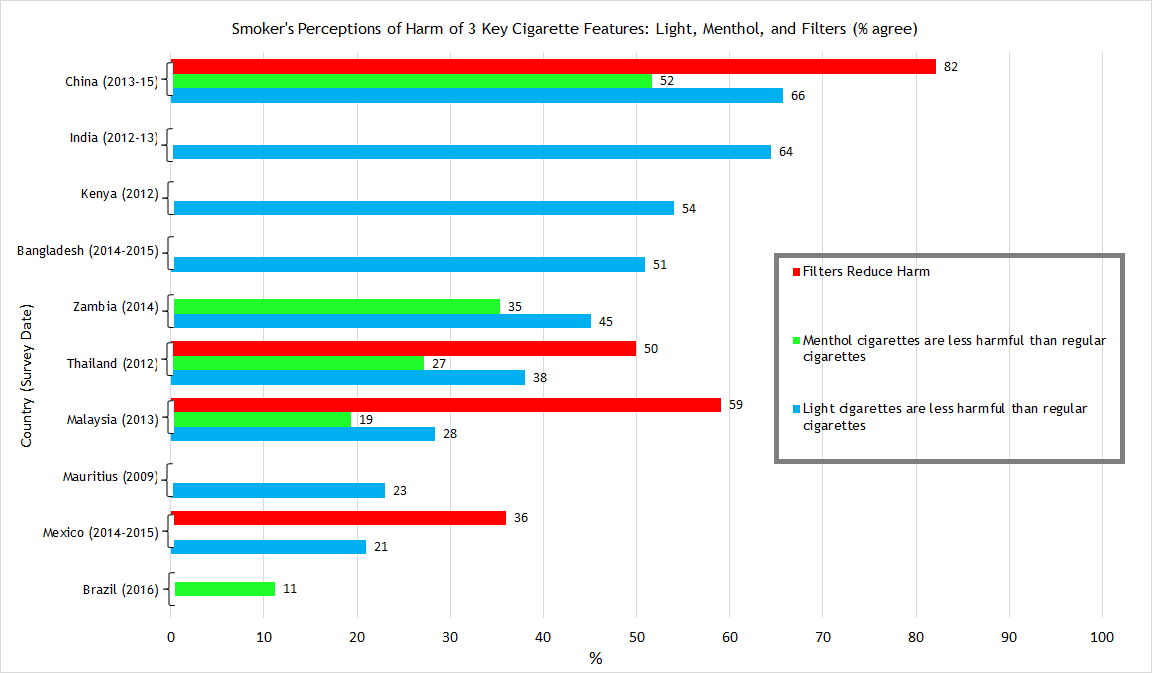Recent manuscripts
Archive
Editorial Board
Aims and Scope
Open Access
Indexing
Contact us
Authorship & COI
Principles of Transparency Checklist
Publication Ethics
Crossmark
Data Policies
Supporting Diversity
Instructions to authors (PDF)
Manuscript Types
Manuscript Formatting
How to submit
Special Publications & Reprints
Preprints
Prevalence of lower harm perceptions of cigarette product characteristics: findings from 10 low-middle-income countries from the ITC project
1
University of Waterloo, International Tobacco Control Policy Evaluation Project (the ITC Project), Department of Psychology, Canada
2
University of Waterloo, Canada
3
University of Zambia, Zambia
4
Kenya Medical Research Institute, Kenya
5
Mauritius Institute of Health, Mauritius
Publication date: 2018-03-01
Tob. Induc. Dis. 2018;16(Suppl 1):A226
KEYWORDS
TOPICS
ABSTRACT
Background:
A major objective of FCTC Article 9, which calls for tobacco product regulation, is to eliminate or reduce tobacco industry product design strategies that have been shown to lead smokers to believe that some cigarettes are less harmful than others. However, nearly all of the studies documenting beliefs about harm perceptions have come from high-income countries; little is known whether the same misperceptions about harmfulness are present in low-middle income countries (LMICs)― where 80% of the world's smokers reside. This study measured the level of perceptions of harmfulness of light and menthol cigarettes among smokers from 10 LMICs of the International Tobacco Control (ITC) Project.
Methods:
Cross-sectional analyses of ITC surveys in Bangladesh, Brazil, China, India, Kenya, Malaysia, Mauritius, Mexico, Thailand, and Zambia were conducted using the country's most recent survey wave (ranging from 2011 to 2016). Adult smokers were asked whether each of three design features— (1) light/low tar, (2) filters, and (3) menthol—were less harmful.
Results:
The percentage of smokers with erroneous beliefs was variable but substantial: 'light cigarettes are less harmful': 21% (Mexico) to 66% (China); 'low tar cigarettes are less harmful': 41% (Zambia) to 71% (China); 'menthol cigarettes are less harmful': 11% (Brazil) to 52% (China); 'filters reduce harm': 36% (Mexico) to 82% (China); 'if a cigarette tastes lighter, it is less harmful': 39% (Zambia) to 71% (Kenya).

[POH 10 LMICs ITC]
Conclusions:
A substantial proportion of smokers in the 10 LMICs erroneously believe that light, low tar, and menthol cigarettes are less harmful, and that filters reduce harm. This is particularly disturbing in China, where prevalence of industry-induced misconceptions was the highest for 4 of the 5 measures. These findings point to the necessity of Article 9 regulations to restrict/ban product design features that mislead consumers about the harmfulness of tobacco products, particularly in LMICs.
A major objective of FCTC Article 9, which calls for tobacco product regulation, is to eliminate or reduce tobacco industry product design strategies that have been shown to lead smokers to believe that some cigarettes are less harmful than others. However, nearly all of the studies documenting beliefs about harm perceptions have come from high-income countries; little is known whether the same misperceptions about harmfulness are present in low-middle income countries (LMICs)― where 80% of the world's smokers reside. This study measured the level of perceptions of harmfulness of light and menthol cigarettes among smokers from 10 LMICs of the International Tobacco Control (ITC) Project.
Methods:
Cross-sectional analyses of ITC surveys in Bangladesh, Brazil, China, India, Kenya, Malaysia, Mauritius, Mexico, Thailand, and Zambia were conducted using the country's most recent survey wave (ranging from 2011 to 2016). Adult smokers were asked whether each of three design features— (1) light/low tar, (2) filters, and (3) menthol—were less harmful.
Results:
The percentage of smokers with erroneous beliefs was variable but substantial: 'light cigarettes are less harmful': 21% (Mexico) to 66% (China); 'low tar cigarettes are less harmful': 41% (Zambia) to 71% (China); 'menthol cigarettes are less harmful': 11% (Brazil) to 52% (China); 'filters reduce harm': 36% (Mexico) to 82% (China); 'if a cigarette tastes lighter, it is less harmful': 39% (Zambia) to 71% (Kenya).

[POH 10 LMICs ITC]
Conclusions:
A substantial proportion of smokers in the 10 LMICs erroneously believe that light, low tar, and menthol cigarettes are less harmful, and that filters reduce harm. This is particularly disturbing in China, where prevalence of industry-induced misconceptions was the highest for 4 of the 5 measures. These findings point to the necessity of Article 9 regulations to restrict/ban product design features that mislead consumers about the harmfulness of tobacco products, particularly in LMICs.
CITATIONS (1):
1.
Beyond Educating the Masses: The Role of Public Health Communication in Addressing Socioeconomic- and Residence-based Disparities in Tobacco Risk Perception
Mesfin Bekalu, Daniel Gundersen, Kasisomayajula Viswanath
Health Communication
Mesfin Bekalu, Daniel Gundersen, Kasisomayajula Viswanath
Health Communication
Share
RELATED ARTICLE
We process personal data collected when visiting the website. The function of obtaining information about users and their behavior is carried out by voluntarily entered information in forms and saving cookies in end devices. Data, including cookies, are used to provide services, improve the user experience and to analyze the traffic in accordance with the Privacy policy. Data are also collected and processed by Google Analytics tool (more).
You can change cookies settings in your browser. Restricted use of cookies in the browser configuration may affect some functionalities of the website.
You can change cookies settings in your browser. Restricted use of cookies in the browser configuration may affect some functionalities of the website.

